Text
New Mutants vol. 4 #18 – Homecoming
The imperative of a mutant community
Vita Ayala (Writer), Rod Reis (Artist), Travis Lanham (Letterer)
Let’s begin with first principles.
The two foundational, definitional characteristics of the New Mutants are the closeness of their bonds, lines between platonic and romantic almost permanently blurred, and their trauma, both individual and shared. The New Mutants’ mission on Krakoa, explored so beautifully in this issue, is to foster a community strong enough that it can guide and support each of its individuals to unburden themselves of the trauma of the past and flourish in the future.
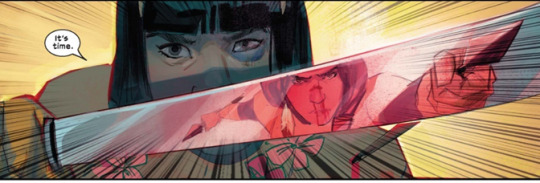
The New Mutants begin their utopian journey in this fashion by creating a support system for younger mutants, no longer constrained by human frameworks and ideologies. This is symbolised by their new home the Sextant, which is itself a metaphor for charting a new course towards a future with limitless possibilities. When Vita Ayala takes over writing responsibilities from Jonathan Hickman from issue 13, they more closely interrogate how this idealism plays out in practice. As the shadow of the past begins to encroach on the Akademos Habitat in the form of Amahl Farouk, the young students are attracted to the allure of easy solutions to their problems. The teachers also perceive Krakoa as an opportunity to release the trauma they’ve held onto for many years but know that this victory must be hard fought. Enter Dani Moonstar aka Mirage to guide them through.
After Magik becomes a War Captain and de facto combat leader of the team, Dani remains the team’s spiritual and emotional leader, as well as the lead educator for the Lost Club, the island’s youngest mutants. While Mirage doesn’t have a story dedicated to her throughout the run, she remains active rather than passive, supporting the team through the period of introspection and reflection that the safety of Krakoa has afforded them.
Ayala uses Mirage to great effect throughout their run, using her innate skill of empathy to de-emphasis the distinction between individual and shared trauma. Ayala’s approach to this feels so realistic, as Dani does not always get this right, avoiding a trap that writers fall into with the character being so morally upstanding that her judgement is beyond reproach. While issue #18 is a wonderful testament to Dani’s strength as a leader and the nature of her bond with Karma, there’s only so much that a community leader can do for her people without wider structural support. Wolfsbane and Cosmar are examples of attentions become spread too thinly, which is a catalyst for calamity and guilt that later issues must resolve. All of Dani’s attention is on Karma’s battle to reclaim her identity by separating her from her ‘evil’ brother Tran, who she has stored in her soul for almost her entire life to protect the world around her. In a society that promises amnesty and support for its former villains, New Mutants #18 examines the precarious moral balance of self-actualisation and community protection through one of the Krakoa era’s most controversial plot devices: the Crucible.
The healing rock
The issue begins with Karma and Mirage sat on a rock by a waterfall, hands held in meditation as Dani facilitates a conversation between Xuân and Tran on the astral plane. This is the same rock that Karma finds Wolfsbane sat on in the opening scene to issue 1 and offers her guidance about capitalising on the potential of her rebirth and finding new purpose. It is a space that symbolises the spiritual connections between the team, and the importance of quiet introspection as a way of resolving problems and challenges. It’s representative of Ayala’s approach to the series, which is to buck the superhero comic trend and resolve issues through philosophical debate rather than physical conflict. That’s not to say that action isn’t core to this issue because it is, but the resolution to the problem is arrived at here on this rock which then plays out in the crucible itself.
Rod Reis’ use of pastel tones and inking to differentiate between the corporal and astral figures and between past and present tense is both economical and visually stunning. The washed out tone clearly demarcates the past tense, while the flare ups of Karma’s pink power signature emphasises Karma’s intense frustration and despair at the lack of success of previous attempts to separate her from her brother. Floating ink lines resembling restraints circle Tran’s body loosely throughout the scene, suggesting Xuân’s reluctance to incarcerate him. At the scene’s conclusion, the inks have become thinner, symbolising the loosening of the bonds and his imminent freedom.

“Tôi đã có bạn - I’ve Got You”
So why is the ritual of the Crucible so crucial to Karma’s story? First of all, it demands conviction. It demands that Xuân reckon with the conundrum of whether her full spiritual independence is worth the risk her brother poses to the community around her. And yes, it demands brutality because the foundational principle of the Crucible is rooted in violence, the premise that paradise should never come easily, even to those who deserve it, because it is simply worth so much.
In the Crucible scenes, Ayala and Reis combine to great effect to simultaneously create a violent intensity and gentle intimacy to the fight. The pacing ebbs and flows as Xuân’s creeping doubts are answered with Dani’s violence before the scene breaks away for Karma to “waver here, in this moment between breathes” as her memories of Tran as an innocent child and as a damaged man as the narrative caption boxes pose the question “who is Tran?”. The fluid, sketched panelling gives way to thick bordering on the bottom panel of the page as the reader sees Karma, sword in hand, resolved in her decision: ultimately, it is not for her to choose. Tran must be given the grace to find his own path.
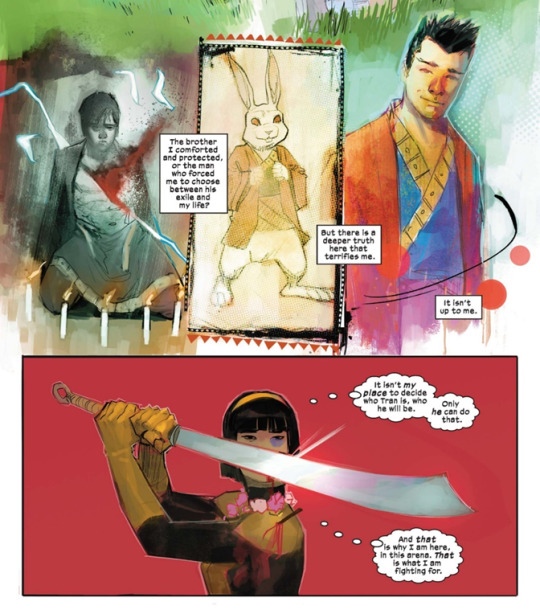
The scene then ramps up to a frenetic yet almost silent crescendo as Dani stabs her with an arrow. Throughout this scene, when the narrative is from the two central figures’ perspectives, the background is dark pink, symbolising Karma’s internality, while everyone else is faded out. It’s just the two of them together, dancing to a song of violence written with pure love. The issue’s closing scene is a moving testament to the love between them, with Karma flirting with Dani as they stare into each other’s eyes in a way that brings us back to first principles: friendship and romance are fluid among the New Mutants, but what is clear is their deep affection for one another.
Other than the potential romantic elements, Ayala’s decision to have Dani be Xuân’s partner is a smart one in that Dani is probably the most self-actualised of the New Mutants. In the original New Mutants series, she was the first to lose her powers, the first to succumb to her trauma in the form of the Demon Bear and therefore the first to be saved by the found family around her. The passing on of care from one community to member to another is contrasted in later issues where the New Mutants talk to the Shadow King about breaking the cycle of trauma and replacing it with something more productive. By separating herself from the pain of her past, symbolised by the influence of her brother, she finally has complete autonomy: freedom to be who she wants but also to pay the kindness forward to others, which she is able to do with Cosmar in a later issue.
So when Karma is resurrected with her prosthetic leg still in place, accompanied by the narrative caption box of “Welcome Home”, the message is loud and clear: mutant paradise is being the version of yourself that you most love and identify with, and the Crucible is the hard road to travel to get there.
The Lost Club
What is striking on a re-read is how much of this issue is dedicated to the Lost Club and the debate between Gabby Kinney and Cosmar about the efficacy of the Shadow King’s promise to restore the mutants to their idealised self. The scenes are very dialogue heavy, which weigh down the issue slightly, but they are important and completely on theme.
The Lost Club, and Cosmar in particular, present an alternative viewpoint on the theme of self-acceptance. If Karma’s decision to resurrect herself with her prosthesis still in place is a strong message of rejecting disability as something to be fixed, Cosmar’s experience is perhaps an allegory for body dysmorphia or more specifically gender dysphoria. The pop philosophy of self-acceptance generally argues that a person should accept themselves for who they are, which implies a rigidity of identity shaped by a patriarchal view of gender. The point that the children with visible mutations like Cosmar, Anole and Rain Boy make to Gabby is that what if what you see in the mirror prevents you from expressing who you are? How can one accept a version of oneself that is false?
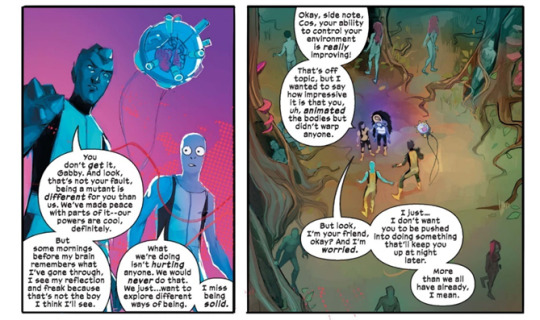
Ayala is challenging a generally held belief in X-Men continuity, perpetuated by the Krakoa era, that possessing a mutant power is necessarily a gift. In the past this notion has generally been challenged by mutants whose powers are destructive, like Rogue or an even more extreme case like Glow Worm, but this comic explicitly is not interested in that. This is about the person behind the powers, and not just whether or not they look “different” from others. This comic is interrogating ways in which people look different from how they perceive themselves, and in that way is an interesting examination of body dysmorphia at the very least.
So while the Crucible scene is a beautiful example of how a community can support the individual, the Lost Club plot is about what happens when a community fails its citizens. The Shadow King, although characterised fairly sympathetically in this run, represents the systems that exploit those left vulnerable by lack of community care. Without spoiling what happens in future issues the seeds of this plot’s central argument are laid here: while they don’t always get it right, the New Mutants have their fellow citizens best interests at heart, and are a positive example of an inclusive and accepting community.
However, the point made by Magik in her letter to the Quiet Council gets to the root of the issue: local communities need the support of central government to best serve its citizens. In an economic and political climate in which vital funding and protective legislation for communities and their vulnerable citizens are being gutted to fund genocide and war, the idealism of Krakoa was always fated to be just another utopia.
10 notes
·
View notes
Text
#xspoilers I loved how Immortal X-Men 9 played with and subverted historic ‘final girl’ characterisations of Kitty Pryde. As those died around her she refused to be a victim and instead of abject terror demonstrated humour and calm.
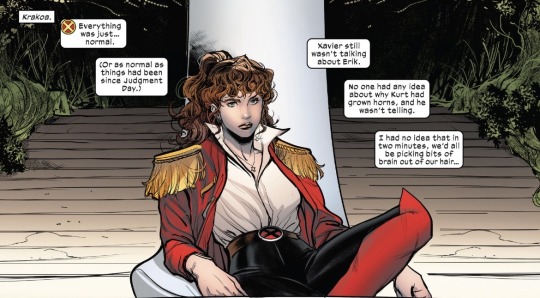
In the early part of the issue, she feigns innocence about the external impact of the Phoenix foundation, instead focussing on corporate image to win over Shaw and evoking Robin Hood to gain his faith.
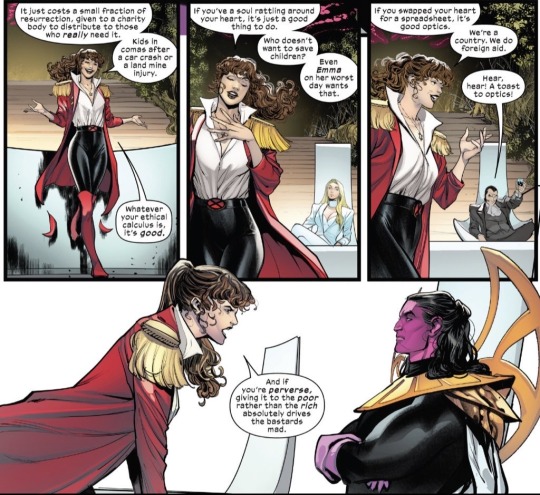
Sinister very much sees Kitty as a final girl: non-consequential. She is neither a priority victim nor potential ally. Her priority rating is the only one that remains unchanged throughout, and is placed straight in the middle of the pack.
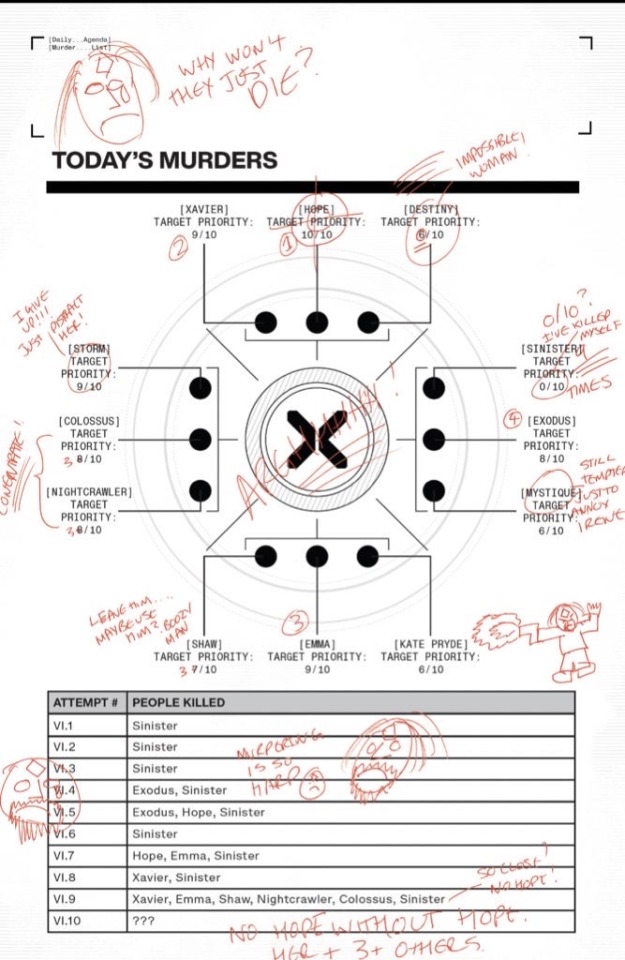
She’s framed looking down at Sinister on a few occasions, a role reversal of victim and perpetrator. By framing the issue around her, she is the one given the agency, even though Sinister’s schemes drive the action.
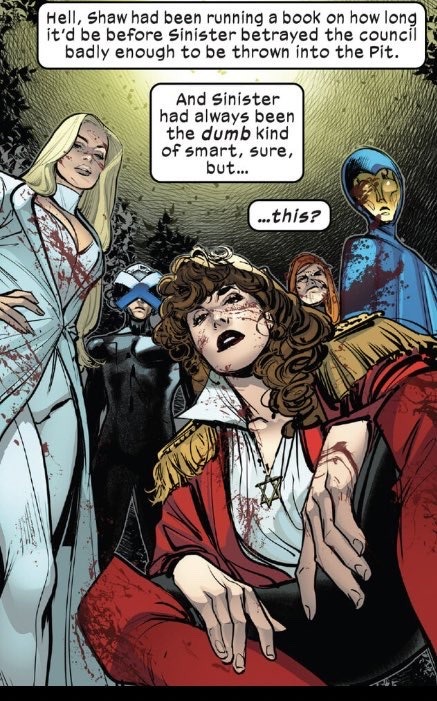
Sinister plays the role of a horror villain, at least in his intent, and Kate breaks out of the boundaries of the story on a few occasions, perceiving the blended genres of horror and farce amongst the chaos that’s unfolding.
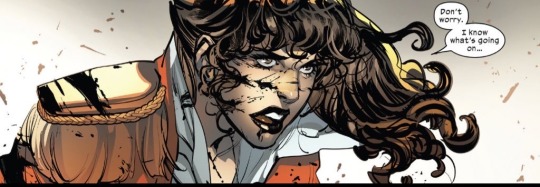
The issue ends with Kate pursuing Sinister, already aware of his destination. By refusing to be frozen in abject terror, it is her leadership and his underestimation of her that may finally see Sinister’s undoing.
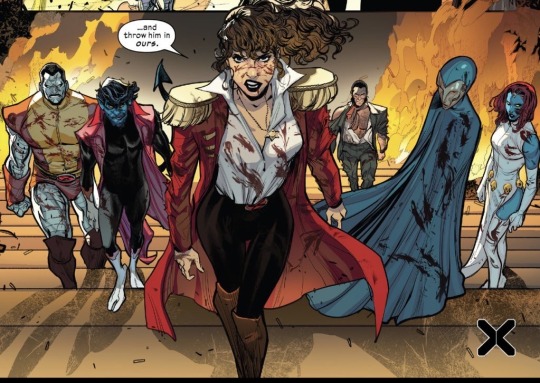
12 notes
·
View notes
Text
What I’ve been reading this week: Spider-Woman (2009)
Brian Michael Bendis and Alex Maleev’s 2009 Spider-Woman run, the first in-continuity comic produced by Marvel, was cancelled after seven issues due to its sheer ambition and the strain placed on the artist. Although sadly truncated, this run is an excellent character study of Jessica Drew, a character Bendis had brought to the fore in his New Avengers run. It begins with Jess living in self-perceived disgrace after it was revealed Skrull Queen Veranke had been impersonating her during the events of Secret Invasion. After some time as a private eye Jess returns to agency work with SWORD, under the persistent and watchful eye of Abigail Brand. The series opens with Jess isolated after the ostensible erosion of her friendships with her fellow Avengers, and her move back into undercover contract work is partially motivated by Brand’s promise of revenge against Skrulls but most pertinently reflects the damage done to her self-worth.
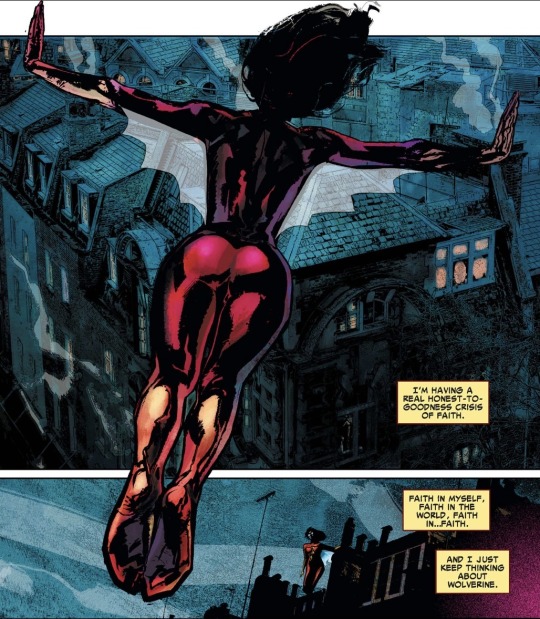
Jess has impersonated someone else her whole life in her roles as undercover agent for both SHIELD and Hydra, manipulated by people promising self-fulfilment and purpose, and it is therefore fitting that she found herself as a pawn in someone else’s game. What she is doing in Madripoor on behalf of SWORD is therefore a toxic repeated pattern of behaviour, exemplified further by the use of chemical powers to emotionally manipulate a police officer who has arrested her. This does nothing but further decimate her self-esteem. She notes: “Because making someone else feel something they don’t want to feel is about the least heroic thing you can do”.
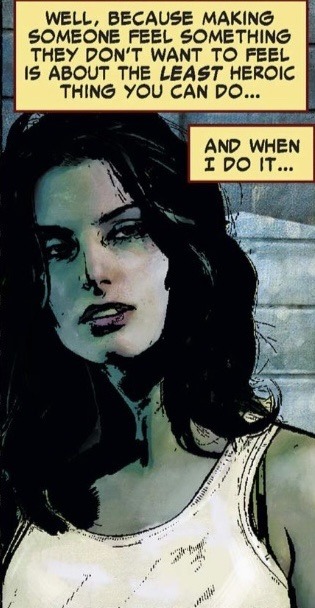
Although her motivation of revenge gives her an initial semblance of self-determination, this is illusory; a fact she is painfully reminded of when Madame Hydra, at the time Viper, frames her for killing a dozen cops before using it as leverage. Viper targets a source of trauma for Jessica, the murder of her mother by her father, as a means of control. She casts herself in the maternal role, remarking upon Jess’ appearance and calling her ‘sweetie’. Jess strongly resists this attempt at manipulation, aware of Hydra’s intentions to weaponise her again, although she is still unable to distinguish this from the nature of her relationship to Abigail Brand. Viper adopts a different tactic and turns the tables on Jess, stating: “I don’t need you. You need us”.
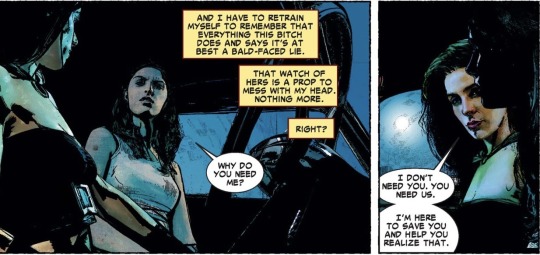
She plays to Jess’ desire for revenge but, although almost tempted when presented with a seemingly defenceless Skrull in Hydra’s prison facility, Jess breaks the cycle of manipulation and escapes.
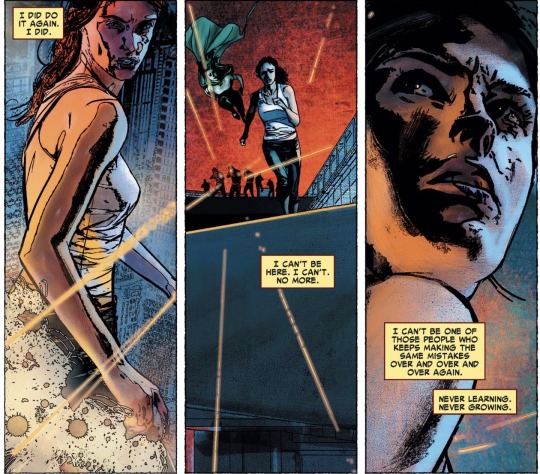
After being attacked by the Thunderbolts, representatives of yet another organisation who seeks to use Jess for their own means, Jess is hassled via instant message by Abigail Brand who makes clear in no uncertain terms that the mission will be completed as she sees fit. Jess tracks the Skrull she’s been hunting to a nearby bar, who goads her by asserting in a fateful case of dramatic irony: “The reason we knew you could be so switched for one of us… is that of all the people in the world…we discovered that no one else on this entire planet cares enough to notice you at all”. Shortly after, her Avengers teammates arrive on the scene and, with their help, she kills the Skrull. She’s reminded by both Carol and Wolverine that people do care for her, and Wolverine’s advice at the end of the last issue pinpoints the crux of the issue perfectly: “When you’re lost, you come home. You don’t run away”. The run ends with Jess flying away again after receiving an offer of another job from Brand, destination unknown.
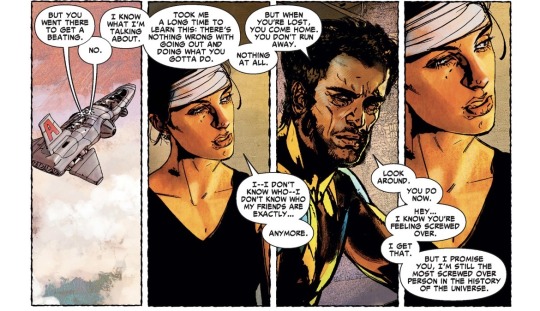
I really enjoyed this run as a Jessica Drew character study, and Maleev’s art combines gritty pencilling with burst of radiant colour as always. Would recommend.
1 note
·
View note
Text
My favourite element of Kelly Thompson’s Captain Marvel is the portrayal of Carol’s friendship group. They quite literally keep her grounded as she tries to carve out a life for herself on earth, while the lure of space remains a constant presence in Carol’s life.
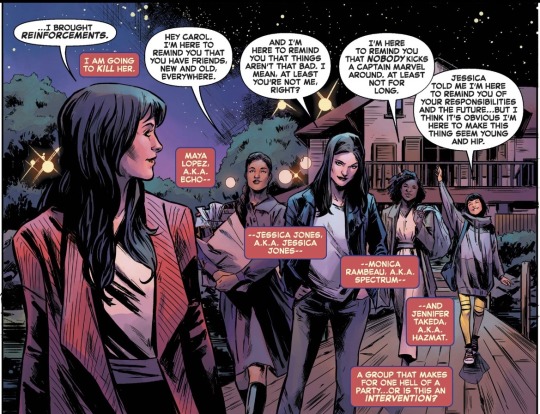
Carol and Jess’ relationship is by far my favourite. Their dynamic is electric. It feels like every time Carol disappears Jess thinks she might disappear for ever, and they clearly miss each other when they’ve been apart.

I loved the exploration of Carol and Wanda’s complicated but restored relationship. It’s part of Wanda’s general atonement arc for past sins but I like how it’s handled here. It’s warm but still a little distant, more transactional than conversational.
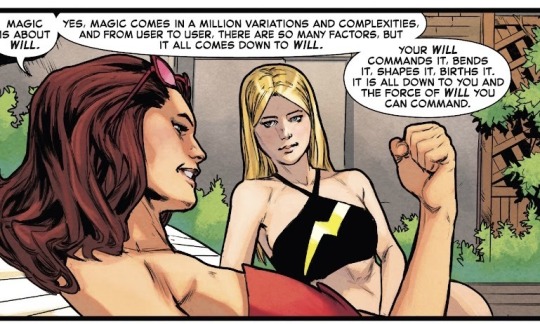
Her relationship with Rhodey has been characterised by Carol’s fate to be a “woman forever torn between two worlds”. She chronically self-sabotages as she never feels settled - “I hate to leave. And yet I cannot wait to go” - but his will is almost as unwavering as hers and my god is he patient.
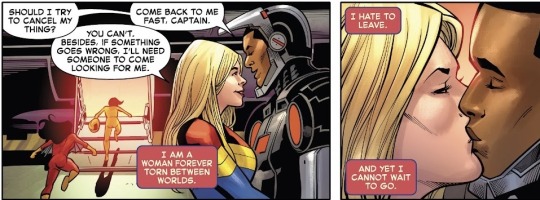
I can’t wait to see her rekindle her relationship with the X-Men as she battles the Brood in the upcoming issues.
37 notes
·
View notes
Text
The romantic tragedy of Mystique and Destiny
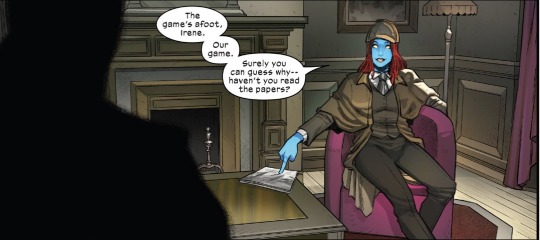
Of the aspects I love about Mystique and Destiny’s relationship is the idea that they’re playing a private game in which they are the only two participants. This panel of Raven with a beaming smile as she says ‘our game’ illustrates this beautifully. However, we’re also reminded in Immortal X-Men 8 that Irene has always been playing her own game, steering the future of mutantkind towards Krakoa.

Mystique trying to infiltrate these secrets but never being able to find all of the clues is so tragic when you consider that mutantkind’s future is one that she cannot be present in and therefore Destiny is forced to keep this from her and to suffer in silence.
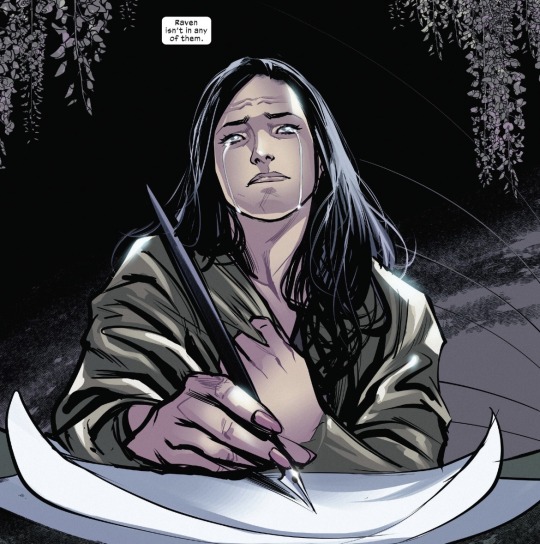
Gillen’s characterisation of their relationship has been the best part of Immortal X-Men so far and will be one of the most moving and lasting legacies of the Krakoa era when it comes to an end.
47 notes
·
View notes
Text
The new mutant language and its revolutionary potential.
Does creating a new mutant language that can describe the lived experience of its users open up new modes of self-expression, and can it be used to challenge the existing power structures on Krakoa?

The two-issue Cypher-focussed X-Men Unlimited Infinity comic carefully builds the argument against homogenous modes of expression and their destructive potential to create immovable barriers within a society’s class structure, which can be applied to the existing power structure on Krakoa. Instead, it encourages diversification of language within a community as a method of creating more effective methods of identifying and communicating the thoughts and feelings of Krakoa’s citizens, creating further opportunities for self-expression and new ways of living. The creation of “Etienne’s language” from the perspective of an outsider who is unable to contain the multitude of potentialities a new language can spawn may provide the seeds for this change to grow and flourish if cultivated correctly.

It is noteworthy that the parameters for a mutant language were set by Professor Xavier. Using telepathy, his vision for Krakoa was implanted telepathically into Doug’s mind to be translated and realised through language in Xavier’s image, which we see in Inferno #2. Krakoan’s inception precedes Krakoa being fully populated and is therefore a prescriptivist linguistic system that cannot reflect the lived experiences and values of its citizens. That is not to say that it hasn’t evolved since but there is limited evidence textually to support that argument.
Doug begins issue 42 by arguing that language contains inherent ambiguities that can be and are used to justify atrocities. During the course of two issues he harnesses a linguistic force that possesses and destroys its hosts from the inside like a “burning lump of coal”. The coal imagery suggests that the language has a finite property in its spoken form, destined to expire unless used shared in written form to tell stories and express the perspectives and emotions of the author. It evokes real-life experiences of dead and dying languages that exist in colonial geopolitical relationships and indeed Etienne, the vessel for this language, can never truly exist on Krakoa in physical form unless the language is shared and understood by a community of people. Cecilia Reyes indirectly poses the question “what does this language want?”. The answer is simple: it wants to live.

Etienne describes language not representative of its people as a ‘tribal marking’, a method of shutting non-speakers out. By definition it creates a uniform mode of expression, an artificially created yet actually applied barrier to an alternative viewpoint. The opposite is also true, it can keep those disadvantaged by the linguistic system within its confines which, as the issue shows can be predatory and destructive in nature, while further advancing the cause of those who hold the power. With limited threat of challenge, the system sustains itself, becoming more and more insular as the wheel turns.
The story ends with Doug laying the foundations for a more productive outlet for the language. As the best translator there is, he is a good yet imperfect custodian. He creates a dictionary, an immortalised record of the language and a method of preserving it. He is therefore functionally assigning denotive meaning to words yet invariably cannot escape connotative meaning, which creates the ambiguities he warns of at the beginning of issue 42. Connotative meaning is created through repeated use amongst a community of people, which is almost always tacitly agreed according to its use within context, by its very nature reflecting the experiences of its speakers. Language describes the ideas and values of its people but also creates the circumstances in which those ideas and values can be lived. Language is therefore given life in its sharing. The initial method of transferring and acquiring knowledge will therefore be key, as arguably only a word’s denotive meaning should be transferred so as to avoid Doug’s assigned connotative meaning created by his poem.
The transitive principle of sound forming thought to inspiring action is exemplified beautifully in Beak’s closing remarks in issue 43. He tells his children they can hear the ocean through a shell but what they hear is echoes, distorted by physical distance and not yet realised. However, these sounds spark an idea that can be described through language, providing a thought that can be turned into action, creating and realising a potentiality that would not otherwise have existed.

The overall potential of diversifying linguistic modes is illuminated through comparing Krakoan to Etienne’s language, which contrasts prescriptivism and descriptivism. Krakoan is something that was prescribed to its citizens upon the nation’s creation. It therefore sets boundaries and parameters within which its citizens can think and act. If used responsibly, Etienne’s language can be used to describe the thoughts and feelings of its people, creating the potential for new ideas to be explored and acted upon.
As with most new systems, it is being introduced into an existing sociological context with established power structures. We have seen from Melter’s experience in Sabretooth, amongst others, that a ‘keep out’ sign is firmly in operation. The language can only flourish through challenging the existing power dynamics on Krakoa, which is unlikely to be achieved unencumbered. Conflict of some kind is therefore likely to be required. We know there is a captive audience hungry for change, but the key question is: can it be the vessel for revolution or is it too little too late, or will a vacuum soon be created that could herald its rise?
7 notes
·
View notes
Text
Destiny Awaits
What does the future hold for the state of Krakoa after the first month of X-books?
After Reign of X ended in incendiary fashion with the thrilling conclusion of Inferno, the last two months of our lives have been dominated by Logan (what’s new there?) and the further emergence of mutantkind’s next great villain. X Lives / Deaths of Wolverine sated our appetite for ten high throttle weeks, but by early March the anticipation for new titles such as Immortal X-Men and X-Men Red had reached fever pitch. Immortal X-Men #1’s release on 30th March signalled the dawning of an exciting new age: the Destiny of X. So far it has not disappointed.
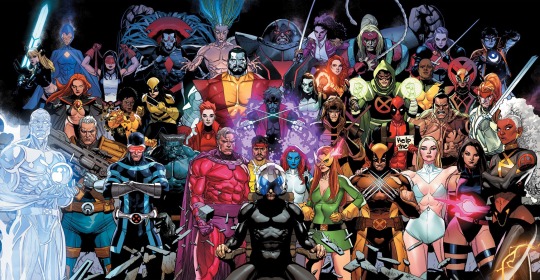
We are now officially one month in to this new era. First issues of many of the new titles have circulated the halls of X-Twitter many times over, stunning revelations and breathtaking moments capturing our collective imaginations with plotlines setting Krakoa on collision course both from without and within.
So, what have we learned so far and what does the future hold for the mutants? Let’s look at some of the key thematic questions posed by some of April’s issues and their potential implications, specifically on Krakoa’s statehood and the power structures within it.
Sinister State Secrets
Gillen’s decision to give Mr. Sinister the floor to provide opening remarks immediately re-establishes Krakoa on rocky foundations. While the fateful threat of human automatons ‘always winning’ looms large, Immortal X-Men is interested in examining how mutants could defeat themselves. Issue 1 ends with the revelation that Sinister has developed a method of retaining memories of the many lives of Moira X through a rigorous cloning regimen. Whilst potentially harnessing untold power, his tendency to surreptitiously play god only for his arrogance to undermine him now threatens the very existence of the timeline and the lives of those within it.
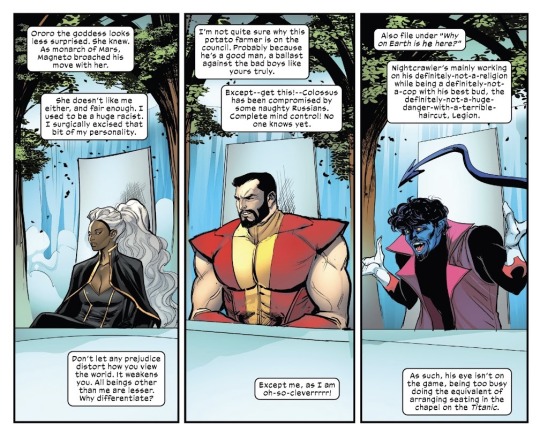
This obsessive proclivity to control through deceit play out throughout the issue. Sinister’s brutally forensic evaluations of each of his fellow Quiet Council members further expose the precarious grounding of these alliances, and his presumed superiority is quickly undercut by Destiny when she confounds Sinister’s expectations in voting against Hope joining the council. Having him as the viewpoint character gives the reader a rare insight into just how loose Sinister’s grasp over power really is as he attempts to keep a cool head.
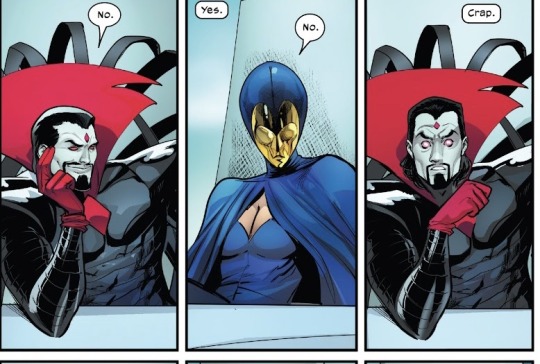
Another significant factor in Destiny’s vote is that she votes against Mystique. Earlier in the issue, we see Irene and Raven’s love and total trust in one another but their power dynamic is defined by Irene’s precognition. It is necessary, she states, for certain information to be withheld from Raven. That said, the events prior to and during Inferno have evidenced the strength of their commitment to one another so it is more likely that the opposing votes were orchestrated to wrong-foot Sinister and conceal their machinations and they remain a formidable dual force within the council. If only it were the evil schemes of easily identifiable villains we needed to worry about.
Beast’s moral corruption has threatened to destabilise Krakoa for quite some time. Left by Xavier to make decisions on national security which have veered into amoral and disastrous interventions in foreign affairs, Beast’s machinations finally caught Emma Frost’s attentions at the gala. In trying to pre-emptively strike against a fledgling enemy in Terra Verde, Hank’s hubris created an enemy far more dangerous, which threatened to damage Krakoa both physically and reputationally, prompting Emma’s intervention. As a result, an agreement between Sage and Emma had been made behind his back to prevent further disaster.
In X-Force Annual #1, Hank was exposed by Sage for concealing the purpose of a mission to extract information from an Orchis base and called in the services of the White Queen. In this scene, Emma’s diamond form is contrasted with Hank’s evasiveness, signifying the solidification of her position against his degenerating control. Emma has come to hold him accountable and he bristles at the affront to his authority and omniscience. It seems, however, that intervention has come too late. Hank has already handed vital information about combatting telepathy over to Orchis.
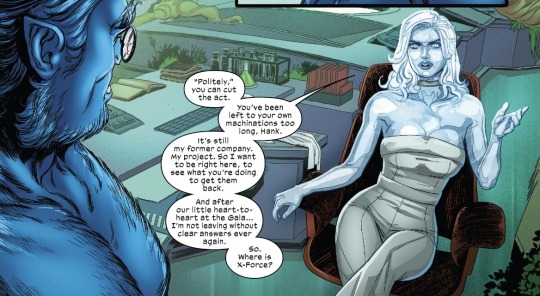
As a further symbol of his waning power, Sage’s public concerns become public in X-Force #27 and she successfully challenges Beast’s demands for Omega Red’s execution. Tragically, Beast’s position is unmoved, such is his misplaced self-aggrandising stubbornness. These stories set up a race against time: will Beast be usurped before he causes further and more severe permanent damage?
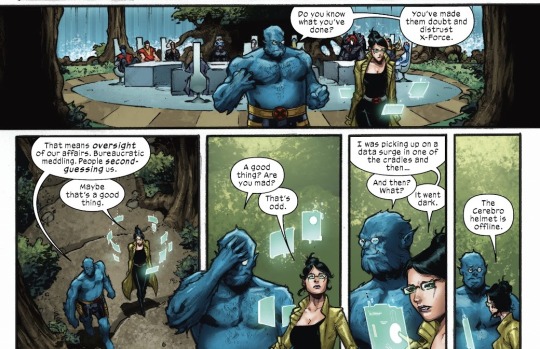
Between Immortal X-Men and X-Force, the tremors of a seismic power shift are already being felt. Magneto’s departure following the ignominy of the events of Inferno have left Xavier weakened. In Immortal X-Men #1 he swiftly moves to vote against Hope Summers but is ultimately defeated. Sinister hints at Hope Summers introduction to the council spells trouble ahead. Other than her unwitting complicity in Destiny’s resurrection, Hope’s actions so far don’t hint at anything nefarious but her strident speech about providing representation to a greater proportion of the population and explicit acknowledgment of the Five’s power suggests a challenge to the existing Krakoan power structures, which is a theme explored throughout the early stages of Destiny of X.
Quiet Council and the question of representation
With Xavier and Magneto undermining the authority of the council through secretly controlling its fate from behind the scenes, the council is now an opportunity for bad actors to manipulate events to their control. As Sinister points out, even those with good intentions such as Kitty, Storm and Kurt’s priorities lie elsewhere, while others like Piotr have been corrupted by adversaries. With the foundations cracking and the old pillars of power eroding, two fundamental questions must be asked: who was Krakoa built for and who does the council represent?
Immortal X-Men #1 and Sabretooth #3 both examine who the council does not represent. Professor Xavier dismisses the idea of appointing Legion to the council out of hand, viewing him only through a lens of distrust and not affording him the same opportunity of redemptions as others more immediately useful to him. Legion represents a philosophical challenge to the council. His mind is a vessel for celebrating difference and imperfection; a sanctuary where all mutants are completely equal. Xavier perceiving this free and communal way of life as incompatible with the council rather than additive preserves the status quo of all mutants solely seeking community and happiness being excluded from decision making. He does not acknowledge that Onslaught, the threat to these mutants very existence on Krakoa who David saved them from, is derived from his moral failings. Whilst there is historical precedent for his suspicion, the fact that Charles merely views Legion as an unstable entity is what denies him from the capacity to accept new ideas; to reform.
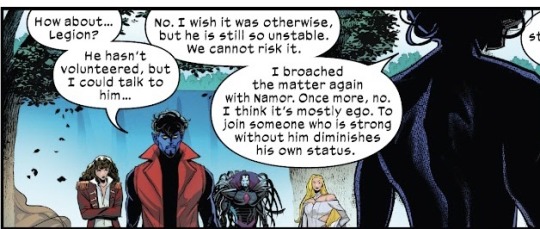
If Legion represents a metaphysical and reformist challenge to the Quiet Council, Sabretooth represents a physical and revolutionary one. Cast out of Krakoa for murdering a human, albeit before the law was constituted, Sabretooth is a complex revolutionary figure. Morally irredeemable, he is an awkward catalyst for revolution on Krakoa for those who feel excluded from matters of statehood. In Sabretooth #3, Melter’s desire to better himself through involvement in leadership on Krakoa is quickly shut down by Xavier. With no connections to pre-eminent mutants to speak of, and no direct usefulness to Charles’ vision, he is immediately removed from society altogether at the first sign of impropriety.
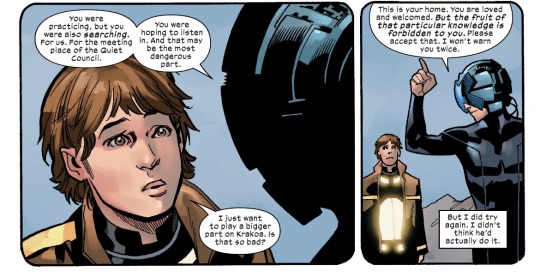
In the issue, we learn that disenfranchisement is rife amongst mutants without standing or usefulness to the council, and the whisperings of revolution begin to form below and in the outer reaches of Krakoa. The spark ignited by Sabretooth seems set to catch fire, but will the ruthless self-serving man dousing the flames end up being what extinguishes the chance of revolution for the forgotten?
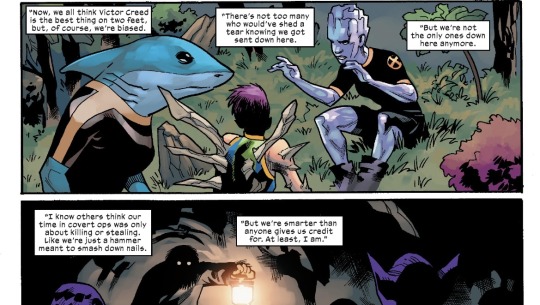
The Space Race
X-Men Red #1 and X-Men #10 extend mutantkind’s purview to Arrakko, concerning itself with a race for control between humans and mutants over the recently terraformed Mars.
In X-Men #10, Feilong seeks to win the hearts and minds of humans to celebrate the human achievement of his space station, inviting a school of children to observe its wonder. Meanwhile, Wolverine rescues Lady Deathstrike from an Orchis base, restoring past bonds broken between mutants in defiance of human cruelty.
In X-Men Red Abigail Brand plays the role of manipulator in chief, sowing seeds of dissention between Krakoan and Arrakki mutants through evoking the language of colonialism. She lurks in the shadows, listening into a conversation between Isca the Unbeaten and Storm and propositions Ororo, capitalising on the uneasy relationship they both have with Storm’s designation as Regent of Arrakko. She suggests that the Arrakki are too unruly for self-determination and that the job of a queen is to impose her will on a culture. Her solution: to create an X-Men team charged with suppressing Arrakki power through law enforcement.
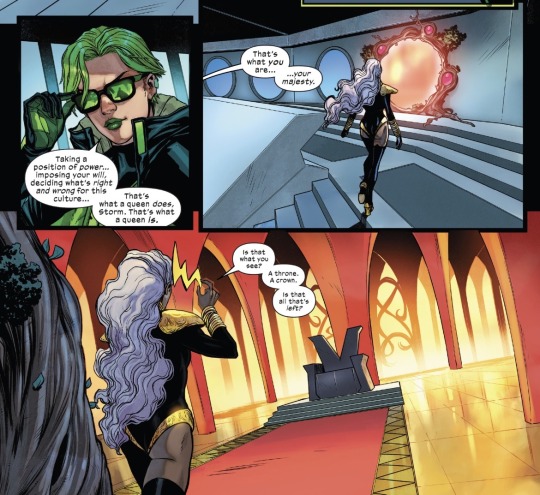
But she has overplayed her hand and miscalculated her influence. Storm immediately rejects the notion, proclaiming that subjugation through royal rule is an unjust way to govern people whose experience is not her own, personified through the No Name shapeshifter who haunts her dreams. Sunspot has noticed Brand’s machinations also and the two come together to create the new Brotherhood, reclaiming a name previously used to imprint mutant supremacy and reconstituting it to create solidarity between mutants against forces that seek to tear them apart.
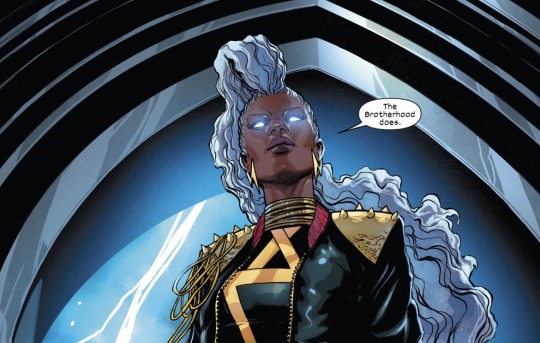
Perhaps Storm is keen to learn the lessons of the Quiet Council, to disavow the actions of Xavier and Magneto in covertly steering events to their will, and to create a society that delivers on its promise to serve all mutants.
10 notes
·
View notes